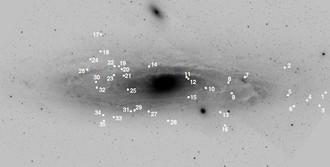Joanna Mikolajewska form the Copernicus Astronomical Center, Nelson Caldwell (Harvard-Smithsonian Center for Astrophysics), and Michael M. Shara (Department of Astrophysics, American Museum of Natural History) made the first detection and determination of charakteristics of symbiotic stars in M31.
Symbiotic binaries are putative progenitors of type Ia supernovae. The census of Galactic symbiotic binaries is so incomplete that we cannot reliably estimate the total population of these stars, and use it to check whether that number is consistent with the observed type Ia supernova rate in spiral galaxies. Mikołajewska, Caldwell and Shara have thus begun a survey of the nearest counterpart of our own Galaxy, namely M31, where a relatively complete census of symbiotic stars is achievable. In a recent paper (arXiv:1406.3080, submitted to MNRAS) they report the first detections and spectrographic characterizations of 35 symbiotic binaries in M31, and compare these stars with the symbiotic population in the Milky Way. These newly detected M31 symbiotic binaries are remarkably similar to galactic symbiotics, though we are clearly only sampling (in this feasibility study) the most luminous symbiotics in M31. We have also found, in M31, the symbiotic star (M31SyS J004233.17+412720.7) with the highest ionization level known amongst allsymbiotics. An optical outburst of theM31 symbiotic star M31SyS J004322.50+413940.9 was probably a nova-like outburst, the first symbiotic outburst detected outside the Milky Way and Magellanic Clouds.
Picture: The distribution of pur new M31 SySt overlaid on the DSS optical image of M31.







